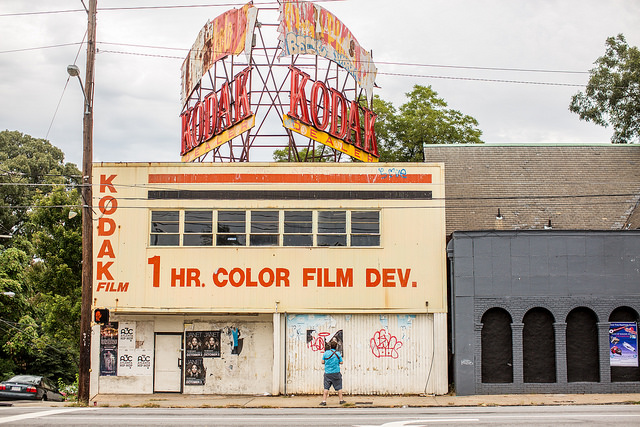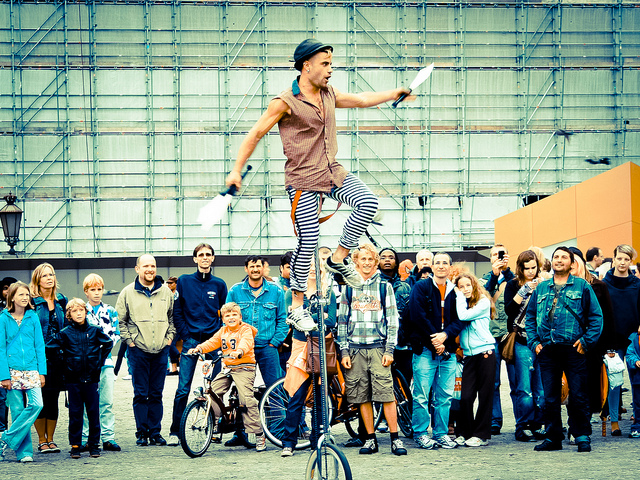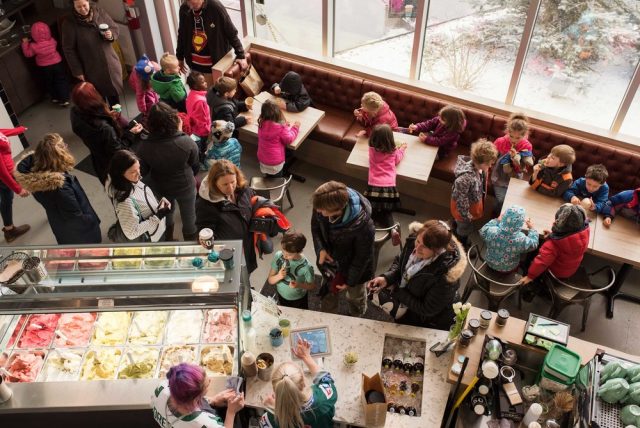Unlock the Magic in Your Story Now
Get the Free 20 questions to Ask Before Launching Your Idea workbook when you sign up for occasional updates.
Get the Free 20 questions to Ask Before Launching Your Idea workbook when you sign up for occasional updates.
Articles filed in: Strategy
We Value What We Measure
filed in Storytelling, Strategy

One of my first jobs was working as the manager of a little Dublin cafe that stood at the intersection of two busy city streets. It was a lot of responsibility for someone in their late teens, and I loved it. There was something magical about opening the shutters first thing in the morning when it was still dark, then putting the lights and the coffee on, ready to welcome the first customers.
We saw the same faces every day. Office workers who grabbed a quick cuppa and a pastry on their way to work, builders who ordered soup or sandwiches for lunch. University students who nursed a cup of tea for hours while they read over their lecture notes in the afternoon.
It was a privilege to become part of customers’ rituals—to be welcomed into their life. We didn’t just exchange money for beverages and convenient snacks. We got to know people. We nourished them and became part of their story.
Our little cafe was the first branch in a chain of cafes, each with its own character and unique location. New branches opened each year. Oliver, the owner, did the rounds of them all. He visited us twice a day. During the lunchtime rush—to gauge the extent of the rush. And at the end of the day to count how much money was in the till. If the takings were up, he was happy. If they were down, his face grew dark, and he began to question why. As Oliver’s empire expanded the money consumed him. He found it hard to see past the coins and bills he could count at the end of the day and even more difficult to connect those totals with an ongoing business strategy. He grew less optimistic about succeeding and more worried about failing with every new branch he opened. Oliver became fearfully reactive to the marketplace instead of bravely responsive to our customers.
He began to cut corners and compromising on quality, ordering food from cheaper suppliers and hiring less staff. He raised prices without giving customers, who were now paying more for an inferior product and service, any notice or a reason. Soon the takings grew smaller as the lines thinned out and business slowed. The staff who had once loved working there left, as day-by-day our little gem of a cafe lost a bit more of its soul.
In a world where data is king, it’s more important than ever to remember that what we measure becomes the thing we’re compelled to act on. There’s nothing wrong with tracking our progress—it’s essential to help us decide on our ongoing strategy. But it’s important to look at progress from every angle, not just the most obvious and easiest one to measure.
Image by William Murphy
Disruption is…
filed in Strategy

The path to building a successful, sustainable business is littered with innovative ideas, requiring brave leadership to prioritise the needs of tomorrow’s customer above today’s bottom line.
Disruption is having the courage to take the customer where they want to go.
Image by Thomas Hawk
Meaning At Work

There is an element of the mundane in every job. Consider the cabin crew who work on long-haul flights. The majority of their work is the repetitive, and strenuous task of wheeling trolleys full of food and drink down narrow aircraft aisles while repeating the same script, ‘chicken or beef’, to the three hundred passengers on board. Many people who choose these roles do so because they tell themselves a story about travel perks and seeing the world. It’s unlikely that they spend much time thinking about how boring handing out bottled water, blankets and sick bags will become. The day-to-day reality of this work could provide an ideal environment for breeding discontent and misery.
If that’s so, why do some people thrive in these jobs, while others become disillusioned? It’s likely that the difference between the people who find joy in the work and those who don’t, have found a way to feel like they’re making a difference. The joyful cabin crew find ways to bring more of who they are to their role. They look for opportunities to gain fulfilment from what they say and do at times when they can go ‘off script’. Like the cabin crew on a recent BA flight who tried to help me make my tight connection (I didn’t), by moving me to the front of the aircraft to disembark. And the stewardess who found me a pair of airline pyjamas to change into just in case I missed the flight and got stuck in the airport (I did), or the hostess in the airline lounge who made me dinner, even though everything had been cleaned and packed away for the night.
It isn’t only our clients and customers who benefit when we bring more humanity to work. The more meaning we can find in our work by being who we are, the more we stand to gain.
Image by Austrian Airlines
The Loyalty Department
filed in Storytelling, Strategy

My mum, (who is in her late seventies) wanted to negotiate the renewal of her internet and phone contract. She dialled the customer support number listed on her bill and was placed on hold for 30 minutes. When she finally got through to a human being, she was transferred to the ‘loyalty department’. She waited on hold for a further 40 minutes before being connected to someone who could help her. The duration of the call was 1 hour 37 minutes and 26 seconds.
This company and other internet service providers are competing on price. Customers see new, cheaper service bundles advertised and are tempted to switch because the pain of switching is outweighed by the savings they will make. Customers no longer see the benefit of sticking with the company they’ve previously been loyal to unless that company price matches its competitors—which is inevitably what happens when existing customers pick up the phone. Customers who persist with the unacceptable call wait times get a better deal. If the loyalty department speaks to too many customers who want to renegotiate their contract, that affects the company’s bottom line.
We spend more resources to woo new customers than we do to earn the continued loyalty of the customers we already have. When the quality of what we sell or serve is barely distinguishable from that of our competitors, we must find other ways to differentiate. One of those ways is by being true to our customers and having a ‘loyalty department’ that lives up to its name. Loyalty shouldn’t only benefit the company—it should work both ways.
Image by Mabel Amber
The Seduction Of New Ideas

We, humans, are novelty seeking organisms. That’s why we find new ideas seductive. We are hardwired to respond to the novel and the new. Our motivation increases when we have a new project to work on. And yet we also have a strong bent towards mastery. We’re happiest when we feel like we’re making progress and making a difference, that’s why it’s important to keep honouring the ideas we’ve been working on with focus and momentum.
Yes, it’s tempting to seek out new opportunities. But we’re rewarded in more ways than one when we intentionally stick with the old thing.
Image by Hernán Piñera
The Three Pillars Of Brand Resonance

The most common reason people give for contacting me to work with them is to raise brand awareness. Conventional wisdom dictates that if only more people knew about our products and services, or our ideas and our work, then we would be more successful. There’s only one problem with this worldview. More people knowing your product or service exists does not necessarily translate to more customers. More awareness doesn’t always make for a more viable business. And crucially, having the biggest audience doesn’t guarantee that you’ll attract the right customers or do your best work.
You don’t need more brand awareness to build a viable business—one that sustains you beyond simply adding the essential zeros to your bank balance. You need more resonance. When you prioritise resonance, you can serve the right people in the right way—a way that’s true to you. To do that you’ve got to be clear about who you’re for and who you’re not for. You must understand what your right customer wants and needs, and be able to explain why your product or service is their best option.
Our messages resonate when we worry less about being discovered and relentlessly pursue the trifecta of self-awareness, customer-awareness and market-awareness instead.
Image by Fiasco Gelato
Change Is A Human Act
filed in Strategy

We mistakenly believe that changemaking and persuasion are only about getting someone’s attention by creating awareness of an issue or option, and then presenting people with rational arguments that will convince them to make choices we find desirable. But both the science and what we witness in the world around us prove otherwise. Research in the fields of psychology and behavioural sciences demonstrates that people make irrational decisions all the time. We are not driven only by reason and logic. Emotions also play a big part in how we react, what we decide, and whether we choose to change.
Persuasion is the ability to change a belief or behaviour. We persuade by appealing to reason or understanding. But the process of persuasion is more complex than just presenting the information and expecting people to make an objective judgement or rational choice. One of the mistakes we make when we’re attempting to persuade is to only appeal to the thinking person and his rational mind. Messages that resonate deeply connect with people’s feelings. Successful ideas appeal to people’s hearts, not just their heads.
We don’t just persuade people to act. We move them to act.
*Adapted from The Right Story.*
Image by Garry Knight
Heartwork
 These words spoken by Director of The London School of Economics, Minouche Shafik, in an interview last year ring true: ‘In the past jobs were about muscles, now they’re about brains, but in future they’ll be about the heart.’
These words spoken by Director of The London School of Economics, Minouche Shafik, in an interview last year ring true: ‘In the past jobs were about muscles, now they’re about brains, but in future they’ll be about the heart.’
The truth is our best work always has been about the heart.
And the good news is that we all start with the same advantage.
Image by Creative Arts Workshop
Bridging The Change Gap
filed in Marketing, Storytelling, Strategy

We know that attention is the first essential step on the path to influencing others. We also know it’s not possible to inspire people to act or to create change with attention alone. There’s always a gap between gaining awareness, enabling action and gaining traction. You can buy attention, but you can’t buy trust. Trust is earned. Trust takes time. Trust is the enabler of connection and persuasion. The time between attention and action is what I call the Change Gap. To close this gap, we must first build trust and then reinforce the opinions and beliefs of the audience we’re trying to reach.

We bridge this gap with connection and persuasion. This is why for example, a hotel’s reviews on websites like TripAdvisor can make or break the business. When every hotel has a comfortable bed and free Wi-Fi, prospective guests are looking for another way to differentiate offerings, and reviews enable them to do that.
The act of persuasion gives people the opportunity to confirm whether what they believe is true. Things like providing more and accurate information, product features, measurements, photographs, pricing, demonstrations, reviews or recommendations help people to decide if your product or service is for them.
There are many real-world examples of companies who have successfully bridged the Change Gap, and industries that have been spawned by doing so. Think about the products and services we didn’t know we wanted but now consume or use regularly. Bottled water, ride-sharing services, reusable coffee cups, coworking spaces, bean-to-bar chocolate, yoga pants, nail bars, coconut oil and meal kits are just a few. The people and companies who convinced so many of us to try these products and services bridged the Change Gap by being purposeful storytellers. The same opportunity is open to you.
*Excerpted from The Right Story.
Image by Garry Knight
